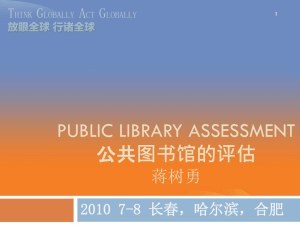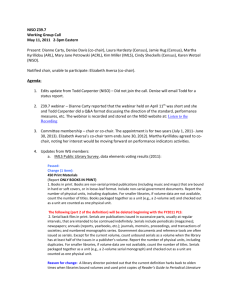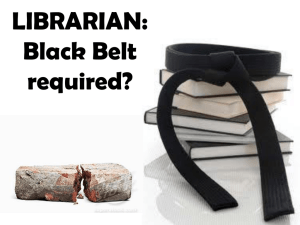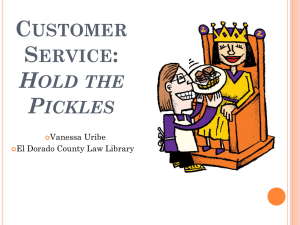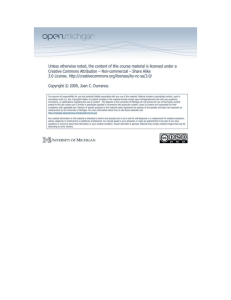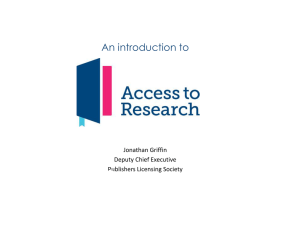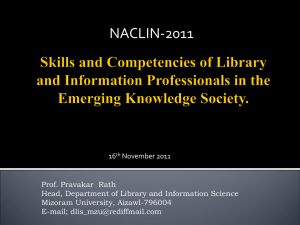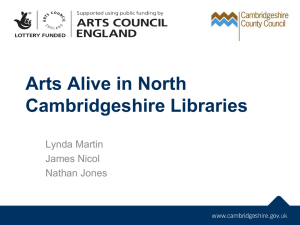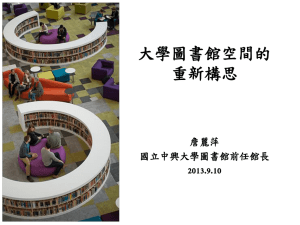Downloads or Outcomes? - Lib-Value
advertisement
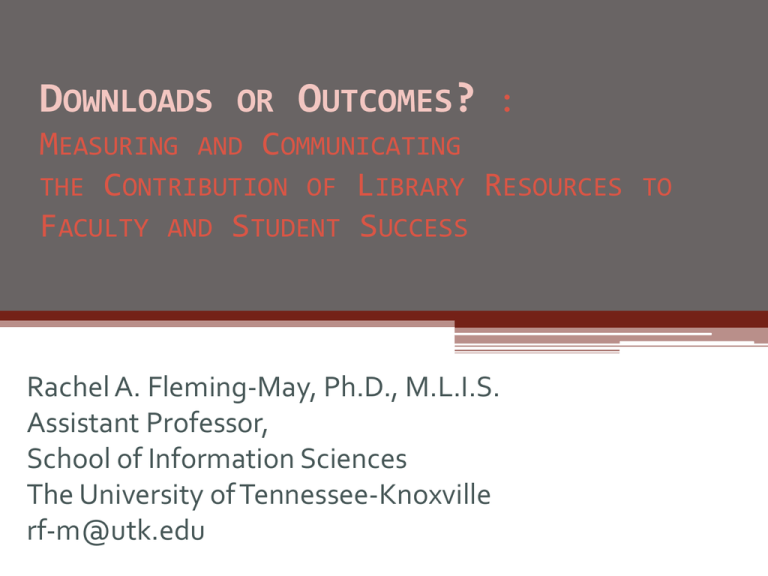
DOWNLOADS OR OUTCOMES? : MEASURING AND COMMUNICATING THE CONTRIBUTION OF LIBRARY RESOURCES FACULTY AND STUDENT SUCCESS Rachel A. Fleming-May, Ph.D., M.L.I.S. Assistant Professor, School of Information Sciences The University of Tennessee-Knoxville rf-m@utk.edu TO • Overview of current concepts and practice related to e-Resource usage measurement Discussion • Alternative and emerging techniques being investigated by the IMLS Lib-Value Project AGENDA: MY INTEREST IN THIS ISSUE: • Former Practitioner at an ARL Library • Dissertation: “Use” in the Literature of LIS—Concept Analysis “What is Library Use? Facets of Concept and a Typology of its Application in the Literature of Library and Information Science” (in an upcoming, but still unidentified, issue of The Library Quarterly) • Use…USAGE—measurement of e-Resource usage With Jill Grogg: The Concept of Electronic Resource Usage and Libraries (Library Technology Reports, Aug./Sept. 2010)1 • IMLS-funded Lib-Value Grant Management Team Member AN EVENT? SOMETHING THAT CAN BE MEASURED? …WITH NUMBERS? Use is often treated as a PRIMITIVE CONCEPT in Library and Information Science: an idea so fundamental to the theoretical framework as to be indefinable, even when presented as a phenomenon to be measured and quantified. USE IS FREQUENTLY ASSESSED IN ORDER TO GENERATE “OBJECTIVE” DATA FOR DECISION MAKING. TO MEASURE USE We focus on Inputs Number of patrons who enter the building …and Outputs …such as the number of book circulations. WHAT ABOUT ELECTRONIC RESOURCES? • Many instances of use are removed from the library, thus unobservable • Multiple points of access (such as Google Scholar) further confuse the issue: patrons are less aware that they’re using library resources “some of the basic ‘natural laws of library and information science’ may not apply as well or as consistently in the realm of electronic information discovery and use”4 “Among other changes, the Complete College Tennessee Act: • Funds higher education based in part on success and outcomes, including higher rates of degree completion.” “Questions such as, ‘Who uses these resources?’ or ‘Are these huge outlays of funds justified in terms of use, or value derived from use?’ or ‘What difference do all of these resources make to students and faculty in universities?’ must be answered if university administrators, trustees, students, and faculty are expected to support ever-increasing levels of funding for the acquisition and development of these resources and services.”5 Understanding USE Matters. SO, IS USE A PRIMITIVE CONCEPT? No. Use does not, in fact, have a singular conceptual meaning in the LIS domain and can signify many actions, processes, and events. THE USE TYPOLOGY: DIMENSIONS I. OF USE Use as an Abstraction Ia. Use as a Facilitator II. Use as an Implement III. Use as a Process IV. Use as a Transaction IVa. Use as a Connector • A GENERAL TERM FOR ALL TYPES OF LIBRARY/INFORMATION USE • DISASSOCIATED FROM ANY SPECIFIC INSTANCE OF THE PHENOMENON “Of the 57,148 households [surveyed], 27,511 (48.1%) had a household member who used the public library in the past year. ”6 USE AS A PROCESS Application of library/information resources, materials, and/or services… To complete a complex or multi-stage task To the solution of a problem “This study reveals that undergraduate students experience information use in a complex, multitiered way that needs to be addressed by higher educators when creating information literacy pedagogy.”7 USE AS A TRANSACTION • Isolated instances of library or information use • Can be recorded and quantified • Removed from the user “statistics provided by electronic book vendors…show that [our] community uses ebooks quite heavily. The data do not show, however, how books are used. For instance, the available statistics show that a book has been accessed but do not differentiate between a one-second click on a title and a five-hour immersion in a book…the data also do not tell us why an electronic version of a book was used instead of the paper version”8 TRANSACTIONAL MODEL OF USE= OVER-RELIANCE ON STATIC ASSESSMENTS ELECTRONIC RESOURCE USAGE, SUCH AS… OF • Vendor-supplied data (COUNTER compliant or otherwise) • Transaction log analysis Including page view time measurement (are they really reading?) Log-ons—what about database timeouts? Not exclusively statistical Visit to the Reference Desk Db A: Log on Article Download UNDERSTANDING OF USE AS PROCESS Requires multiple data collection methods Requires “bipartisan” support, i.e., working with public services to gain a fuller understanding of how and why patrons use the resources they do. HOW, SPECIFICALLY? • Observation • Focus groups • Interviews • Surveys • Inter-institution information sharing • Usability testing • Triangulation. THE LIB-VALUE PROJECT: • Grant funded by IMLS, December 2009-2012 • Principal Investigators: Carol Tenopir, University of Tennessee Martha Kyrillidou, Association of Research Libraries Paula Kaufman, University of Illinois …other participants include librarians, academic faculty, and other researchers from multiple institutions and disciplinary backgrounds • Purpose: “…to study the value of academic libraries to students, faculty, policymakers, funders…” and Return on Investment (ROI) in academic libraries • Follows two previous projects: Phase I: Return on Investment in Academic Library (UTK and U of IL) as measured by successfully funded grants9 Phase II: Expanded to 8 international universities10 IS LIB-VALUE DIFFERENT? • It’s a Comprehensive Effort to analyze Value and ROI using models that incorporate all inputs in the library system (faculty, staff, students, library resources) and determine how each influences the system articulate all values of the library and areas of investment and return Teaching/ Learning Scholarly Endeavors HOW Research Social/ Professional e-Science Collaborative Scholarship Institutional Repositories Functional Areas Slide adapted from Carol Tenopir’s presentation, “ForumValue, Outcomes, and Return on Investment of Academic Libraries (Lib-Value) (funded by IMLS)” at the January, 2010 ARL Assessment Forum, Boston, MA. KEY QUESTIONS: • Does the reputation of a university’s library influence Enrollment? Recruitment of faculty and students? Material or financial donations? • Do library resources and/or services play a role in Student success? Retention? WHAT CAN PROJECT? PRACTITIONERS EXPECT FROM THE • A fact-based articulation of the value and ROI of the university library resources and services within the wider mission of university administration. • Develop a model for ROI and tools that implement this model which can be used by other academic libraries. Modular: libraries will be able to choose from a “menu” of approaches depending on the particular services and/or resources they wish to assess Slide adapted from Carol Tenopir’s presentation, “ForumValue, Outcomes, and Return on Investment of Academic Libraries (Lib-Value) (funded by IMLS)” at the January, 2010 ARL Assessment Forum, Boston, MA. QUESTIONS? Thank you for your time! 1. Fleming-May, Rachel A., and Jill E. Grogg. 2010. The concept of electronic resource usage and libraries. Vol. 46, Library Technology Reports. 2. Swigger, Keith, and Adeline Wilkes. 1991. The use of citation data to evaluate serials subscriptions in an academic library. Serials Review 17 (2):41-46; 52. 3. Miller, Rush, and Sherrie Schmidt. 2002. E-Metrics: Measures for Electronic Resources. Serials: The Journal for the Serials Community 15 (1):19-25. 4. Peters, Thomas A. 2002. What's the use? the value of e-resource usage statistics. New Library World 103 (1172/3):39-47. 5. Ibid. 6. Sin, Sei-Ching Joanna, and Kyung-Sun Kim. 2008. Use and non-use of public libraries in the information age: A logistic regression analysis of household characteristics and library services variables. Library & Information Science Research 30 (3):207-215. 7. Maybee, C. (2006). Undergraduate Perceptions of Information Use: The Basis for Creating UserCentered Student Information Literacy Instruction. The Journal of Academic Librarianship, 32(1), 79-85. 8. Levine-Clark, Michael. 2006. Electronic Book Usage: A Survey at the University of Denver. portal: Libraries and the Academy 6 (3):285-299. 9. Luther, Judy. 2008. University investment in the library: What's the return? In Library Connect White Papers. 10. Tenopir, Carol. 2010. University Investment in the Library, Phase II: An International Study of the Library's Value to the Grants Process. In Library Connect White Papers.
